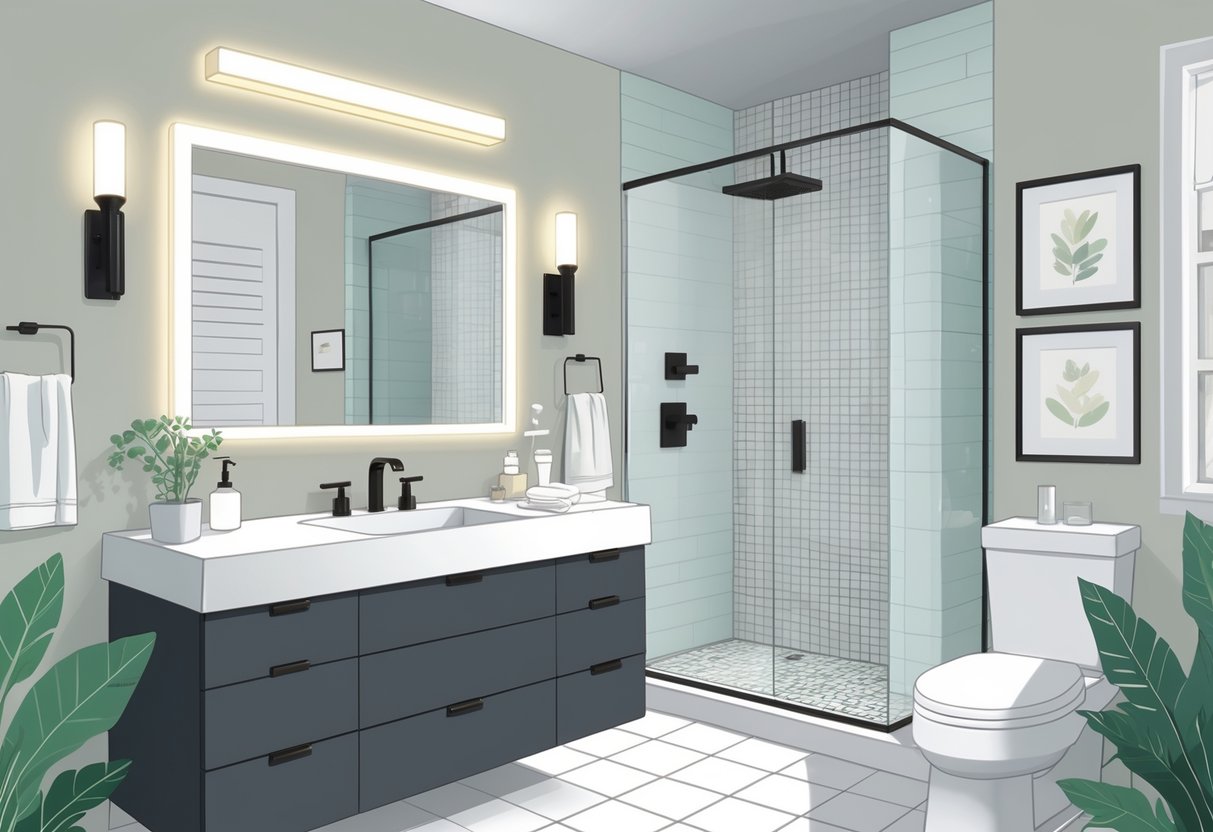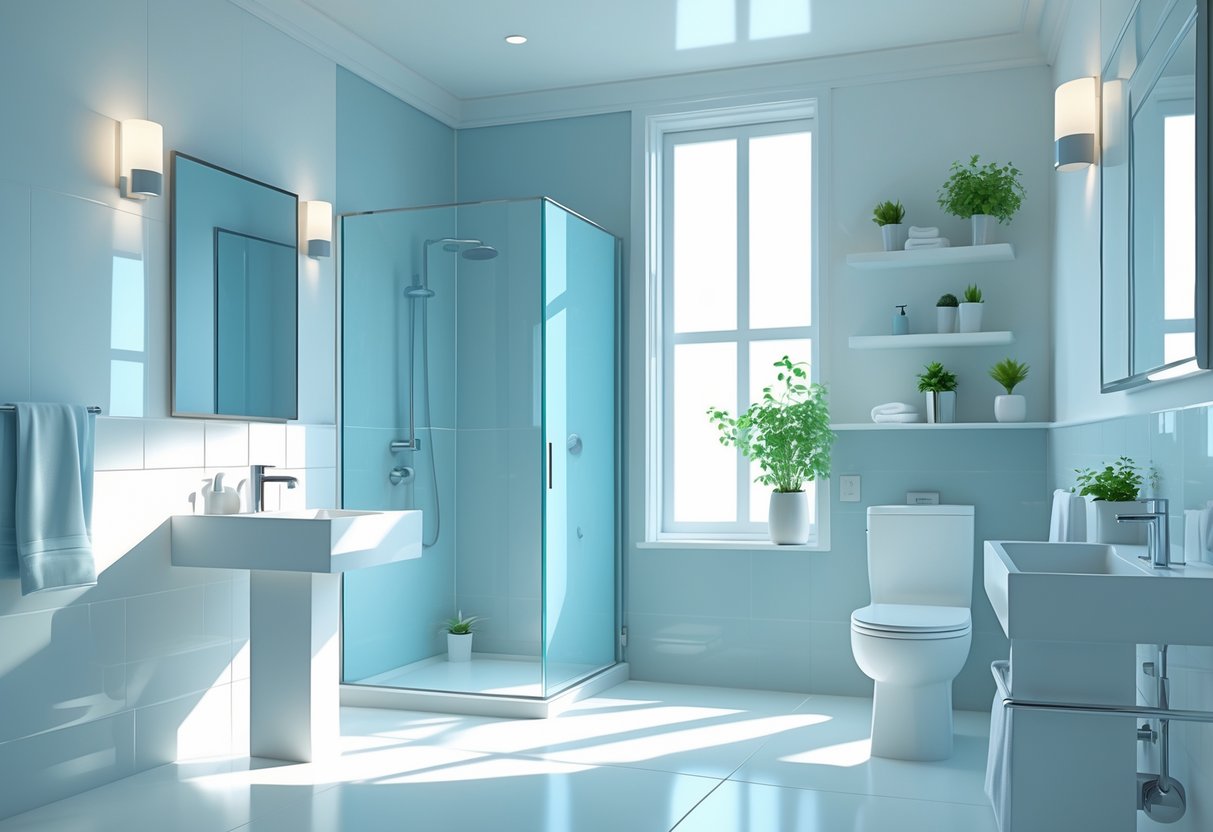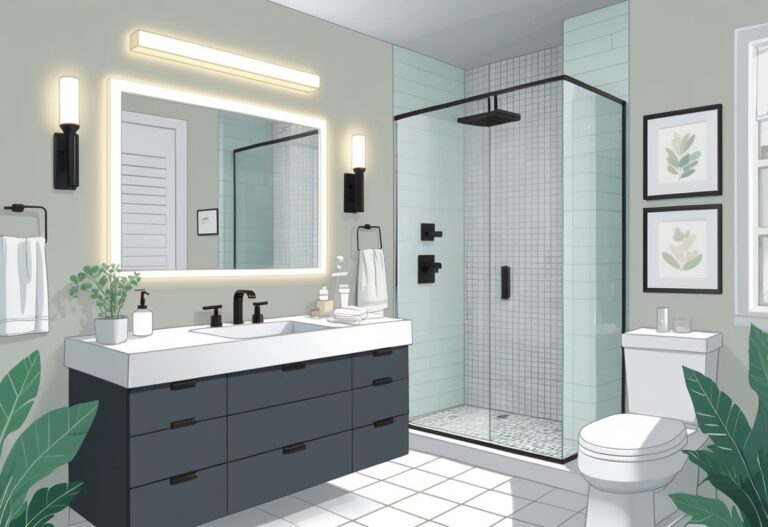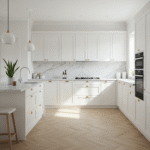Bathroom remodels have the power to totally change a space—without draining your wallet, if you play your cards right. With renovation costs creeping up in 2025, people are hunting for clever ways to refresh their bathrooms and still stick to a budget.
Things like new flooring, swapping out fixtures, or just improving the lighting can make a surprisingly big difference for not a lot of money.

The trick to keeping remodels cost-effective is focusing on changes that look good right away and hold up over time. Even simple things—like paint, better storage, or switching to energy-efficient lighting—can really change how a bathroom looks and works.
You don’t need a full-blown renovation to get a modern, updated vibe. Just a few targeted updates can get you there.
Need a Home Fix – Emergency or Routine?
From leaks and no-heat nights to simple tune-ups, our 24/7 hotline connects you with trusted local pros in minutes.
1) Install peel-and-stick vinyl flooring for an affordable, stylish upgrade
Peel-and-stick vinyl flooring is honestly one of the easiest, most budget-friendly ways to give your bathroom a facelift. It’s way cheaper than hardwood or tile, but still looks really nice.
You don’t need fancy tools or to call in the pros. Each plank or tile comes with adhesive backing—just peel, stick, and you’re set.
These days, vinyl flooring comes in tons of designs. Some look so much like real wood or stone, you’d have to get down on your hands and knees to tell the difference.
Vinyl’s great for bathrooms since it handles water better than hardwood and is less expensive than ceramic tile. It’s a solid pick for wet spaces like bathrooms or laundry rooms.
Most folks can knock out this project in a weekend. Plus, you can usually lay vinyl right over your old floor, which saves a ton of hassle and cash.
It stands up well to scratches and daily wear, too. Not bad for something you can install yourself.
2) Replace old fixtures with matte black or brushed nickel faucets and showerheads
Swapping out tired faucets or showerheads is a quick way to make your bathroom look new. Fixtures are usually the first thing you notice when you walk in.
Matte black brings a bold, modern look. It’s trendy, but not so out-there that you’ll regret it in a few years.
Brushed nickel is a classic—versatile and easy to match with almost any style. It’s everywhere for a reason.
Both finishes are way cheaper than redoing the whole bathroom, but they really stand out. Most people can handle replacing fixtures with just a few basic tools.
Brushed nickel is typically a little easier on the budget. Matte black might cost a bit more, but sometimes it’s worth it for that extra pop.
Usually, you can just swap new fixtures onto your existing plumbing. No major headaches required.
Matching all your fixtures for a cohesive look really pulls the room together. It’s a small thing, but it makes a big difference.
If your current hardware looks tired or dated, this is a fast fix that’ll make the whole space feel fresher.
3) Use washable, semi-gloss paint in light shades to brighten and enlarge the space

Semi-gloss paint is kind of a no-brainer for bathroom walls. It handles moisture way better than flat paint and doesn’t get gross as quickly.
The slight shine helps bounce light around, which makes the space feel bigger and brighter. Light colors work best for this effect.
It’s easy to clean, too. You can wipe away splashes and fingerprints without messing up the finish.
Light-colored semi-gloss can make even a tiny bathroom seem more open. The reflective quality and pale shades just work together.
It’s not more expensive than other paints, but it lasts longer in steamy rooms. That means less repainting down the line.
Semi-gloss works for walls, trim, or doors. It has enough shine to reflect light, but not so much that it feels like a funhouse mirror.
Regular household cleaners usually do the trick for keeping it looking good. No need for fancy products.
Stick with white, cream, or pale shades if you want the biggest impact. Those colors really open up the room.
4) Add open shelving with reclaimed wood for functional, attractive storage
Reclaimed wood shelves are a great way to add storage and a bit of personality. They’re usually cheaper than buying new wood, and each piece has its own vibe.
Most people can install open shelves with just a drill and a level. No need to hire anyone unless you really want to.
Reclaimed wood brings warmth to bathrooms that can otherwise feel kind of cold. The natural grain and worn look add interest to blank walls.
They’re practical, too—perfect for towels, toiletries, or a few plants. Open shelves make it easy to grab what you need and keep things tidy.
Reclaimed wood works with almost any style, from modern to rustic. It’s surprisingly versatile.
Just sand and seal the wood before you hang it up. That’ll help it stand up to bathroom humidity.
Floating brackets keep the look clean and modern. Wall-mounted shelves are ideal for saving space, especially in smaller bathrooms.
Open shelving means less clutter on your counters. It’s a simple way to stay organized.
5) Upgrade lighting with LED vanity lights to improve ambiance and energy efficiency
LED vanity lights are a game-changer for energy savings. They use up to 80% less electricity than old-school bulbs and still give you plenty of light.
There’s a style for everyone, from ultra-modern to more classic looks. It’s not hard to find something that fits your bathroom.
LEDs give you better, more even light for things like shaving or makeup. No more weird shadows on your face.
Wall-mounted sconces at eye level work best. They cut down on harsh shadows and give you flattering light at the mirror.
Switching to LEDs usually means lower electric bills. You’ll probably notice the savings pretty quickly.
They last way longer than incandescent bulbs, so you won’t be changing them out all the time. Less hassle, less waste.
New LED vanity lights can even bump up your home’s value. Buyers like updated, efficient lighting.
Many models let you dim the lights, which is handy for different times of day or just setting the mood.
Understanding the Value of Cost-Effective Bathroom Remodels
Making smart upgrades in 2025 can pay off, but only if you know what’s worth the money. Bathroom remodels aren’t cheap—the average runs between $10,000 and $25,000—so planning is kind of a big deal.
Evaluating Return on Investment in 2025
Bathroom remodels are almost always a good bet for adding value. Most projects return 70-80% of their cost when it’s time to sell.
The trick is picking upgrades that buyers actually care about. Stuff like modern fixtures, better lighting, and fresh tile work tend to give you the best bang for your buck.
High-ROI bathroom upgrades include:
- Updated vanities and countertops
- New faucets and lighting fixtures
- Fresh paint and modern hardware
- Improved storage solutions
- Energy-efficient features
Returns vary by location—urban homes often see better payback than rural ones. It’s worth checking out your local market before diving in.
Timing matters, too. If you remodel within 5-7 years of selling, you’re more likely to get your money back.
Common Budgeting Mistakes to Avoid
Lots of people underestimate how much a bathroom remodel will cost—sometimes by 20-30%. That leads to delays or having to cut corners when money runs out.
The biggest budgeting errors include:
- Skipping the contingency fund (should be 10-20% of total budget)
- Ignoring permit and inspection costs
- Underestimating labor expenses
- Choosing cheap materials that need quick replacement
Moving plumbing or electrical can make costs skyrocket. It’s usually cheaper to keep the existing layout if you can.
Go for quality where it shows—like flooring or countertops. You can save on the stuff that’s hidden behind walls.
Sometimes it’s better to pay for professional installation. DIY projects can backfire and end up costing more if you have to fix mistakes later.
Material Selection for Long-Term Savings
Picking the right materials can save you money on maintenance and replacements down the road. Eco-friendly and low-maintenance options are usually the best value over time.
Modern Eco-Friendly Materials
Bamboo flooring is 30-50% less expensive than hardwood and lasts 20-25 years. It’s more moisture-resistant than most woods and grows back fast after harvesting.
Recycled glass tiles are durable, cost $8-15 per square foot, and don’t need sealing. They’re stain-resistant, mold-resistant, and come in tons of colors.
Low-VOC paints are just a couple bucks more per gallon than regular paint, but they’re better for air quality and health. Many brands offer 15-year warranties now.
Reclaimed wood vanities cost 20-40% less than new custom pieces. They look great and help cut down on waste. With a good seal, reclaimed wood can last 15-20 years in the bathroom.
Water-saving fixtures like low-flow toilets and showerheads can knock $100-200 off your annual utility bills. They usually pay for themselves in a couple years.
Low-Maintenance Finishes and Fixtures
Quartz countertops don’t need sealing and stand up to stains, scratches, and germs. They’re not cheap ($50-90 per square foot), but they can last more than 20 years.
Luxury vinyl plank flooring is super durable, handles moisture, and costs $3-7 per square foot. It’s easy to clean and can last 15-20 years if you treat it right.
Ceramic and porcelain tiles are easy to maintain—just basic cleaning. Bigger tiles mean fewer grout lines, so less scrubbing and less mold.
Chrome and stainless steel fixtures resist tarnish and corrosion. They’re easy to wipe down and keep shiny for a decade or more.
Semi-gloss or satin paint finishes are easy to clean and stand up to moisture. They cost about the same as flat paint but last twice as long in steamy bathrooms.
Frequently Asked Questions
People always have questions about affordable bathroom updates. Whether it’s about small spaces, which materials to pick, or how to save on labor, there’s a lot to consider.
What budget-friendly options are available for updating a small bathroom’s aesthetics?
Small bathrooms really shine with a few smart changes. Try a light-colored paint in a washable semi-gloss—it brightens things up and even makes the room feel bigger.
Peel-and-stick vinyl flooring is a wallet-friendly way to ditch outdated floors. It’s way cheaper than traditional tile and you can usually handle it yourself.
Open shelving, especially from reclaimed wood, adds both storage and personality. These shelves are less pricey than built-ins and bring in some texture and warmth.
LED vanity lighting is a solid upgrade for both function and mood. They sip energy and outlast old-school bulbs, which is always a bonus.
How can I calculate the cost of a DIY bathroom remodel?
Start by measuring your bathroom and jotting down everything you’ll need—think flooring, paint, fixtures, and any extras. It’s easy to forget the little stuff, so double-check your list.
Check prices at home improvement stores and online. Comparing materials can save you a surprising amount if you’re patient.
It’s wise to add about 10-15% to your total for the “just in case” moments. Projects always seem to uncover something unexpected, right?
Labor costs basically vanish with DIY, but tool rentals can sneak up on you. If plumbing or electrical gets tricky, you might still need a pro for those parts.
What are the top five low-cost upgrades that make the biggest impact in a bathroom renovation?
Swapping in new fixtures gives an instant facelift. Matte black or brushed nickel faucets and showerheads can really modernize things.
Fresh paint makes a huge difference for not much money. Lighter shades bounce light around and help small bathrooms feel more open.
Flooring is a game-changer. Peel-and-stick vinyl holds up well and looks good, all without the big price tag of tile.
Lighting is underrated. LED vanity lights are bright, even, and can help trim your energy bills.
Smart storage, like open shelves with reclaimed wood, keeps things tidy and adds a bit of rustic charm.
Can you suggest ways to save on labor costs during a bathroom remodel?
DIY works great for basics like painting and putting up shelves. Most folks have the tools and skills for these jobs.
If you’re up for it, removing old fixtures and flooring yourself saves a chunk of cash. Less work for the pros means a smaller bill.
Buying materials on your own helps dodge contractor markups. It pays to shop around and compare prices.
Sometimes you can snag lower rates by scheduling work in the off-season. Contractors tend to offer deals during slower months, especially in winter.
What cost-effective materials can be used for bathroom flooring and tiling?
Peel-and-stick vinyl flooring is tough, water-resistant, and easy on the budget. It usually goes right over what you’ve already got.
Ceramic tiles are solid for both walls and floors. Tons of colors and styles, plus they handle moisture like a champ.
Laminate flooring made for bathrooms is cheaper than hardwood but still looks the part. Newer options do surprisingly well with humidity.
Painted concrete floors bring an industrial vibe for next to nothing. They fit right in with basement or modern bathroom designs.
How does the size of the bathroom affect the overall remodeling expenses?
Smaller bathrooms need less material, so you’re usually looking at lower costs. Paint, flooring, and fixtures just don’t have to cover as much space.
With compact areas, you’ve got fewer fixture options. That can make decisions easier and sometimes keeps prices down, plus things tend to move along quicker during installation.
But honestly, small bathrooms can throw some curveballs. Custom solutions for tight spots might actually bump up the price compared to just using standard stuff.
Interestingly, labor time doesn’t always shrink with the room. It’s more about how tricky the installation is, not just how many square feet you’re dealing with.







Leave a Reply